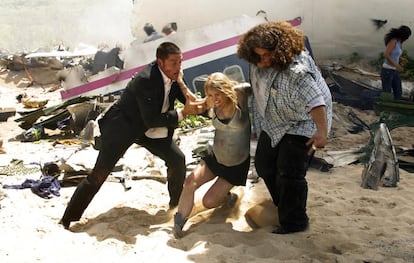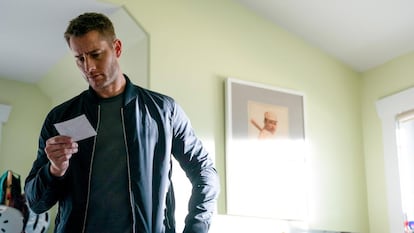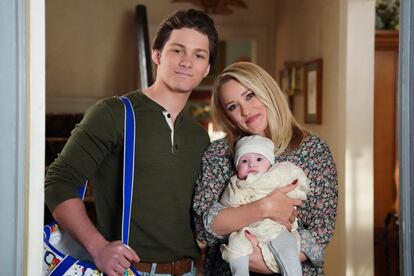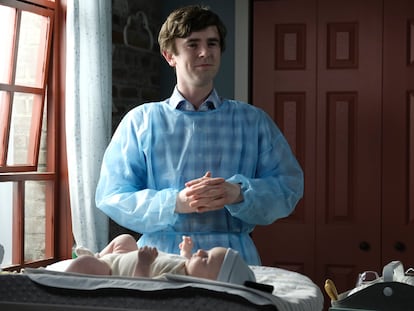The pilot episode, an American television tradition in danger of extinction
Free-to-air channels have gone from producing hundreds of test episodes to almost none, a phenomenon that reflects a change in an industry more concerned with cutting costs than originality


Just 20 years ago, Lost ushered in a new era for television series, and for all the fanaticism that surrounds them. So much so that, in 2004, before the dawn of the streaming platforms, when many worldwide viewers downloaded the first episode of the series about the mysterious island, they learned a new term when they saw it’s title: Pilot (Part I). What did the word refer to? Perhaps the pilot of the crashed plane? Or was it the name of the episode?
Viewers in the U.S. are far more familiar with the term. For decades American television has baptized test episodes as pilots, a calling card for new series with which their producers and backers hope to convince the television channels to commission further episodes. It was a proven formula for success. The opening episode of Lost was until then the most expensive in history, with a budget of more than $10 million. But since Oceanic Flight 815 went missing, almost everything has changed in a TV industry that today relies on platforms. Pilots are an endangered species and the networks have taken with them a conglomerate that moved billions of dollars and created hundreds of jobs. According to The Hollywood Reporter’s estimate, 98 pilot episodes were filmed in 2013. This season, 12 years later, they can be counted on the fingers of one hand.
In the original 30 Rock pilot, Jenna Maloney’s character was not played by the iconic Jane Krakowski, but Rachel Dratch, who would later be used in cameos as various different characters. The Office was a shot-for-shot copy of the British original. And in The Big Bang Theory’s original unaired pilot there was no Penny. Nor was Alyson Hannigan Willow on Buffy. Sometimes the twist was more drastic. Star Trek, from 1966, kept only Leonard Nimoy as Spock from its cast, although its original pilot has been gaining so much fame that the cut characters ended up getting their own continuation series in 2022.
Filming a pilot was arduous and left victims along the way, from actors to demoralized screenwriters, but it also served to polish and improve. When it paid off, it paid off handsomely. The studios looked for the best in each project, backed by data, even though not everything could always be considered good: Seinfeld, for example, worked terribly in its early incarnations. What did they do? They added Julia Louis-Dreyfus to provide a female vision. It did not do Seinfeld any harm.
A 2016 report in The Wall Street Journal noted that the firm Screen Engine screened 250 pilots a year in front of test audiences. Each cost on average $5 million. Do the math. That money doesn’t reach anyone anymore. There were actors who only went to Hollywood to shoot pilot after pilot to see if they could finally make a breakthrough. From January to May, the pilot industry was rolling. Pedro Pascal, for example, shot the Wonder Woman pilot in 2011. Rejected. Months later, he starred in the comic book adaptation The Sixth Gun. Rejected. Edie Falco and Kathy Bates filmed their own Fargo in 2003. Rejected. Greta Gerwig (known today for directing Barbie) made How I Met Your Dad. Rejected. HBO said no to pilots with Jane Fonda and Ewan McGregor and shot superhero projects like Doctor Strange, Nick Fury (with David Hasselhoff) and Justice League of America. None saw the light of day beyond the test screenings.
The most-watched free-to-air channel in the U.S., CBS, is unabashedly embracing the change of era: “Pilots aren’t dead, I would say pilot season is probably dead for us because why should we be held to that very specific window anymore, nobody else is,” said CBS president Amy Reisenbach this May when presenting the new pilot season. That detail reveals much more about the TV industry’s era of cost-cutting, accelerated by the 2023 writers’ and actors’ strikes. The mantra is to keep the purse strings closed. The goal “is basically to reduce pretty dramatically our investment in content,” warned Disney chief Bob Iger during one of those same conferences before advertisers. ABC, Disney’s commercial television network and broadcaster of Lost, will only program five fictional series in the fall.
In February, the head of the FX network, John Landgraf, announced in his annual report that in 2023 the production of fictional series had dropped for the first time in a decade (except for during the first year of the Covid pandemic): by 14% to 516 premieres. The figure is not negligible, but in 2022 it was 600.
Fiction is expensive and, without so many viewers tuning in, it is no longer worth it. There is a clear example. In the 2013-14 season, the most-watched series on free-to-air in the U.S. was NCIS, with 18.5 million viewers. This year it was Tracker, also on CBS, with 8.3 million. If Intelligence, cancelled after 13 episodes in 2013, were in the ranking today, it would be one of the five most-watched series. In the top 10 today it’s all cop and firefighter franchises, except for two comedies: the Big Bang Theory spin-off Young Sheldon and the U.S. remake of Ghosts.
The free-to-air channels have less at stake. This year they have given the green light to a spin-off of the spin-off Young Sheldon (Georgie and Mandy’s First Marriage); a police spin-off version of Fire Country; the remake of Matlock; the new Suits in Los Angeles; a sequel to The Office based around journalists, and the umpteenth NCIS, a franchise that has now run for over 1,000 episodes. Why spend millions on pilots in the face of dwindling numbers?

The free-to-air channels have less at stake. This year they have given the green light to a spin-off of the spin-off Young Sheldon (Georgie & Mandy’s First Marriage); a police spin-off version of Fire Country; the remake of Matlock; the new Suits in Los Angeles; a sequel to The Office based around journalists, and the umpteenth NCIS, a franchise that has now run for over 1,000 episodes. Why spend millions on pilots in the face of dwindling numbers?
Although this trend is not so noticeable in streaming, the cutbacks have reached the platforms, which often share ownership. HBO sells its productions to the highest bidder, with Netflix, for example, streaming Band of Brothers or Sex and the City. And they launch packages together to attract subscribers. Max joined forces with Disney+, and Comcast with a Netflix/Peacock/Paramount+ offering. Mergers won’t be long in coming.

Netflix killed the pilot star
The platform that turned the tables was, as usual, Netflix. HBO never wanted test pilots with audiences because they had a “creative vision that couldn’t be measured without context,” the company said in 2016. But while Amazon made test pilots available on its website, Netflix was launched with already completed first seasons. It was a strategy that everyone is copying today, but which is also problematic: if everything fails to click in a first episode, it is difficult to make a show work in six episodes shot on the fly.
Today’s platforms are also competing for advertising with the traditional channels while adding live shows, reality shows and, above all, sports to their offer. Streaming is becoming more and more like old-fashioned television, but there is one aspect that seems to have been consigned to the past: pilots, and the multi-million-dollar industry around them. Recently, Max greenlit a new series from John Wells (of ER fame). The Pitt, a medical drama, has no big stars, is procedural, and spending has been moderate. It sounds like a television show from the days of ER, except for one thing; it landed a 15-episode order with no guarantee of success.
This is not only is a new way of doing business, it also translates into fewer buyers, fewer scripts, fewer opportunities, less originality, and fewer jobs. “People are scared,” one screenwriter told The Hollywood Reporter in April. “Teams are filled with veterans and the only scripts they buy are from proven writers.” The end of pilots is just another symptom of television’s tinplate age.
Sign up for our weekly newsletter to get more English-language news coverage from EL PAÍS USA Edition
Tu suscripción se está usando en otro dispositivo
¿Quieres añadir otro usuario a tu suscripción?
Si continúas leyendo en este dispositivo, no se podrá leer en el otro.
FlechaTu suscripción se está usando en otro dispositivo y solo puedes acceder a EL PAÍS desde un dispositivo a la vez.
Si quieres compartir tu cuenta, cambia tu suscripción a la modalidad Premium, así podrás añadir otro usuario. Cada uno accederá con su propia cuenta de email, lo que os permitirá personalizar vuestra experiencia en EL PAÍS.
¿Tienes una suscripción de empresa? Accede aquí para contratar más cuentas.
En el caso de no saber quién está usando tu cuenta, te recomendamos cambiar tu contraseña aquí.
Si decides continuar compartiendo tu cuenta, este mensaje se mostrará en tu dispositivo y en el de la otra persona que está usando tu cuenta de forma indefinida, afectando a tu experiencia de lectura. Puedes consultar aquí los términos y condiciones de la suscripción digital.
More information
Archived In
Últimas noticias
Trump claims peace in Ukraine is near, but Moscow suggests otherwise
A survivor’s account of the Interoceanic Train accident: ‘We were scared because of the speed on the curve’
The Interoceanic Train, the Mexican alternative to the Panama Canal
What is known about the Interoceanic Train derailment in Oaxaca
Most viewed
- Oona Chaplin: ‘I told James Cameron that I was living in a treehouse and starting a permaculture project with a friend’
- Reinhard Genzel, Nobel laureate in physics: ‘One-minute videos will never give you the truth’
- Why the price of coffee has skyrocketed: from Brazilian plantations to specialty coffee houses
- Pablo Escobar’s hippos: A serious environmental problem, 40 years on
- Chevy Chase, the beloved comedian who was a monster off camera: ‘Not everyone hated him, just the people who’ve worked with him’










































